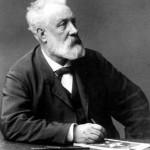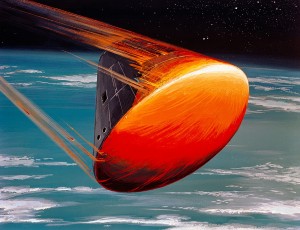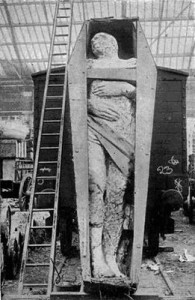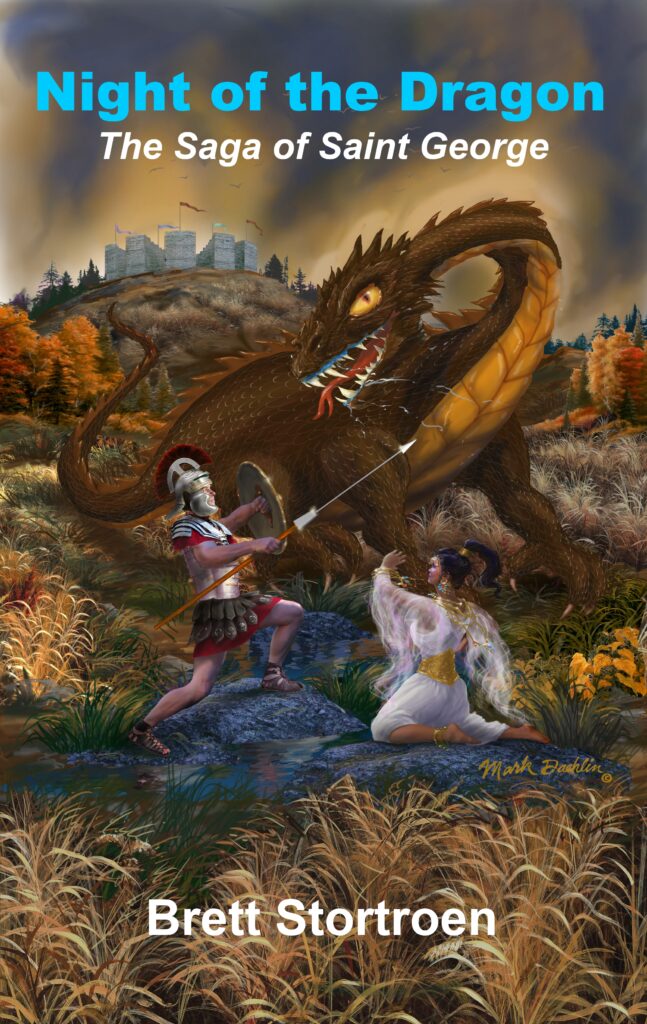Jules Verne (February 8, 1828 – March 24, 1905) was a French writer best known for his science fiction and adventure stories. Verne’s uncanny ability to foresee future technological inventions have astounded many for over a century. His wealth of knowledge was amazingly comprehensive in numerous scientific and historical subjects as demonstrated throughout his writings. In an article titled, Verne, Jules—Gabriel, 1828-1905, William Butcher recounts some of Jules Verne’s literary scientific predictions:
“Whatever the reason, there certainly are many bold innovations in the works from 1886: an aeroplane/helicopter, a pneumatically-driven train under the Atlantic, a giant cannon designed to correct the earth’s axis, perfect audiovisual reproduction, a trans-Siberian railway, a motorized floating island, and a project to turn the Sahara into an extension of the Mediterranean. One short story, first published in English (by Michel) and called ‘In the Year 2889’ (1889), describes such innovations as: the disappearance of horse-drawn transport, trains at 1500 km/hr, worldwide news in colour, weather control, a life expectancy of sixty-eight years, communication with the planets, algebraic computers, aerial publicity, skyscrapers, and a reduction of the chemical elements first to three basic units and then to one. In ‘L’Eternel Adam’, the major novelty is that ‘the secrets of the phenomenon of life had been successfully explored […], and the tremendous discoveries that had been made allowed one to foresee that organic beings could soon receive the gift of immortality’. But the works set in the future do not have a monopoly of ‘predictions’. In other works, as well, one can observe such innovations as: the extensive role of electricity, various submarines, an explosive which is claimed by its inventor to be capable of blowing up the globe, and laser, telecontrol, artificial rain, radiotelephone, and torture by means of electric shock. Amongst particular events ‘predicted’, the most striking is the fact that Verne’s moon-rocket is the same height and weight as Apollo 8, like it is launched from Florida and observed by means of a giant telescope in the Rocky Mountains, and splashes down in the Pacific at a point only four kilometres away from that where Apollo 8 did.”[1]
Most of the public remembers Jules Verne for his predictions of future scientific achievements. However, Verne was similarly well schooled in history and biblical scriptures with an astute understanding of the ancient past. His knowledge of the sciences and history weave through the pages of his classic “Journey to the Center of the Earth.” In the novel, Professor Hardwigg (Professor Lidenbrock, 1877 edition) and his nephew Harry (Axel, 1877 edition) voyage to the center of the Earth based upon an enigmatic coded message. The two men examine one of the professor’s latest acquisitions; an original runic manuscript of the Heimskringla by Snorri Sturluson which chronicles the history of the Norwegian kings and decipher a hidden coded note in the book written by a fictional alchemist, Arne Saknussemm. He describes a route to the center of the Earth through the volcano Snæfell in Iceland. Intrigued by the clues and thrill of discovery, the two set out to follow in the footsteps of Saknussemm. Along the way they enlist the assistance of a loyal and rugged Icelandic guide named Hans.
Once in the depths of the Earth, they discover amazing creatures, as if they were from the Quaternary period. Upon discovering a large human skull the professor reflects upon the race of giants in remote antiquity. His mind flashes back to his teaching days:
“Professor Hardwigg, carried away by his enthusiasm, forgot all the circumstances of our journey, the extraordinary position in which we were placed, the immense cavern which stretched far away over our heads. There can be no doubt that he thought himself at the institution addressing his attentive pupils, for he put on his most doctoral style, waved his hand, and began: ‘Gentlemen, I have the honor on this auspicious occasion to present to you a man of the Qaternary period of our globe. Many learned men have denied his very existence, while other able persons, perhaps of even higher authority, have affirmed their belief in the reality of this life. If the St. Thomases of paleontology were present, they would reverentially touch him with their fingers and believe in his existence, thus acknowledging their obstinate heresy. I know that science should be careful in relation to all discoveries of this nature. I am not without having heard of the many Barnums and other quacks who have made a trade of suchlike discoveries.”[2]
Here Verne has painted the character of the professor as a believer in the existence of actual giants. Next, he continues to acknowledge that in the past, there have been a few cases of mistaken identity in the analysis of giant skeletal remains.
“I have, of course, heard of the discovery kneebones of Ajax, of the pretended finding of the body of Orestes by the Spartiates, and of the body of Asterius, ten spans long, fifteen feet-of which we read in Pausanias. ‘I have read everything in relation to the skeleton of Trapani, discovered in the fourteenth century, and which many chose to regard as that of Polyphemus, and the history of the giant dug up during the sixteenth century in the environs of Palmyra. You are well aware as I am, gentlemen, of the existence of the celebrated analysis made near Lucerne, in 1577, of the great bones which the celebrated Doctor Felix Plater declared belonged to a giant about nineteen feet high. I have devoured all the treatises of Cassanion, and all those memoirs, pamphlets, speeches, and replies published in reference to the skeleton of Teutobochus, king of the Cimbri, the invader of Gaul, dug out of a gravel pit in Dauphine, in 1613. In the eighteenth century I should have denied, with Peter Campet, the existence of the preadamites of Scheuchzer. I have had in my hands the writing called Gigans—’ Here my uncle was afflicted by the natural infirmity which prevented him from pronouncing difficult words in public. It was not exactly stuttering, but a strange sort of constitutional hesitation. ‘The writing named Gigans—’ he repeated. He, however, could get no further. ‘Giganteo—’ Impossible! The unfortunate word would not come out. There would have been great laughter at the Institution, had the mistake happened there. ‘Gigantosteology!’ at last exclaimed Professor Hardwigg between two savage growls.”[3]
Several of the skeleton remains described above have been determined to be those of elephants or mastodons (mammoths) while others are dubious in nature. However, Verne continues the subterranean narrative in support of real human giants:
“Yes—not more than a quarter of a mile off, leaning against the trunk of an enormous tree, was a human being—a Proteus of these subterranean regions, a new son of Neptune keeping this innumerable herd of mastodons. Immanis pectoris custos, immanior ipse! Yes—it was no longer a fossil whose corpse we had raised from the ground in the great cemetery, but a giant capable of guiding and driving these prodigious monsters. His height was above twelve feet. His head, as big as the head of a buffalo, was lost in a mane of matted hair. It was indeed a huge mane, like those which belonged to the elephants of the earlier ages of the world. In his hand was a branch of a tree, which served as a crook for this antediluvian shepherd. We remained profoundly still, speechless with surprise.”[4]
Jules Verne cited a few examples of faulty or inconclusive evidence as a caution. But in the novel he appears to support the notion of real giants existing based upon his character, Professor Hardwigg. Nevertheless, hundreds of historical accounts and many giant skeletal remains have been documented. Verne may have been aware of this other positive data as alluded to in his novel. Perhaps, he believed in the veracity of human giants in antiquity; we may never know for certain. Unfortunately, many of the real artifacts have been scurried away in the back rooms of museums; much akin to the movie Indiana Jones and the Raiders of the Lost Ark, where the legendary “Ark of the Covenant” remains hidden and sealed in the back of a warehouse. Other alleged cases have been purposely destroyed or been classified as off limits to the public. Jules Verne stands as a legend in his prescience of both past and future events.
Sources
[1]William Butcher, Verne, Jules-Gabriel, 1828-1905, [http://jv.gilead.org.il/butcher/encycl.html] (accessed Dec, 2013).
[2]Jules Verne, The Jules Verne Collection (34 of Jules Verne’s classic novels with an active table of contents for each piece)(A&L Ebooks. Kindle Edition, 2007), Kindle Locations 10742-10768.
[3]Ibid.
[4]Ibid., Kindle Locations 10882-10892.
Related Links:
101 Pics That Prove Nephilim Giants Existed.

Jules Verne’s Antediluvian Giant by Brett Stortroen is licensed under a Creative Commons Attribution 4.0 International License.

















